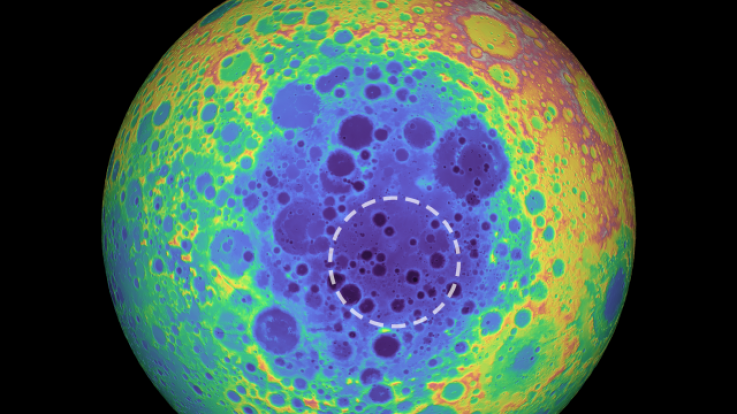Scientists have discovered a huge, mysterious mass of material beneath a large crater on the Moon. The mass is five times bigger than Hawaii's Big Island and is located hundreds of miles beneath the lunar surface.
Researchers led by Peter James from Baylor University, Texas, were studying the structure of the South Pole-Aitken Basin. This is an impact crater that stretches about 1,600 miles in diameter. It is one of the biggest impact craters of the known solar system but, because it is located on the far side of the moon, cannot be viewed directly from Earth.
In their paper, published in Geophysical Research Letters, the team was investigating changes to the moon's gravity. They used data from NASA's Gravity Recovery and Interior Laboratory (GRAIL) mission. This is a mission that aims to create a gravitational map of the moon, while also providing an insight into its internal structure and composition.
When the team combined the GRAIL data with topographic information taken from the Lunar Reconnaissance Orbiter, they discovered the huge, anomalously dense mass. The researchers do not know what the mass is, but it appears to extend down beneath the moon's surface by over 180 miles.
Researchers say it could be a huge lump of metal from the asteroid that formed the South Pole-Aitken basin. Instead of sinking down into the moon's interior, it remained buried in the moon's mantle. Computer simulations suggest that this is a plausible explanation, but other explanations have also been proposed.
"Imagine taking a pile of metal five times larger than the Big Island of Hawaii and burying it underground. That's roughly how much unexpected mass we detected," James said in a statement.

"We did the math and showed that a sufficiently dispersed core of the asteroid that made the impact could remain suspended in the Moon's mantle until the present day, rather than sinking to the Moon's core."
Another source of the unexpected mass, researchers say, could be a concentration of oxides that could have formed when the magma ocean that existed on the moon solidified.
Whatever the mass is, the team believes it can explain some of the features of the South Pole-Aitken basin—specifically that the central depression of the crater is being weighed down by this mass, rather than being caused by the contraction of the "melt sheet"—found where impacts take place.
Finding out how the South Pole-Aitken basin formed is important to understanding the history of the moon and its evolution. "The South Pole-Aitken basin is the largest preserved impact basin on the Moon and perhaps the largest universally recognized impact structure in the solar system," the team wrote. "While larger impact events undoubtedly occurred throughout the solar system during planetary accretion, most indications of these events were erased through subsequent bombardment and thermally induced viscous relaxation. The SPA basin therefore is an important remnant of a process that shaped solar system bodies into their present forms."
The space agencies of several nations, including the U.S. are currently focusing on missions to the Moon. NASA recently announced its Artemis mission, which aims to put the first woman on the moon by 2024.
https://www.newsweek.com/moon-mystery-mass-discovered-far-side-1443304
2019-06-11 09:51:25Z
CAIiEPYDaWtyiltzcspcSh8Y9acqGQgEKhAIACoHCAow77zbCjDiq8wBMKiCsgU
Tidak ada komentar:
Posting Komentar